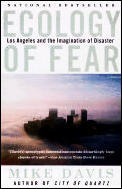October 28, 2008 Categories: Reviews
Ecology of Fear:
Los Angeles and the Imagination of Disaster
Mike Davis
1998. Vintage. 484 pp. $15.95
Mike Davis knows all about LA, and he knows that almost everything you think you know about it is wrong. Behind the benevolent Southern California climate lies the potential for all kinds of disasters — and behind those disasters lies a century and a half of systematically foolish and ignorant development choices, choices that have turned a beauty spot into a trouble spot. “Blade Runner” wasn’t nearly imaginative enough.
How can a book with this theme be so compulsively readable? When you really understand a place, you know where to find the inconvenient truths, which are usually the best stories.

There’s the late great Los Angeles River. Frederick Law Olmsted, Jr. and Harlan Bartholomew preferred to control its flooding by “strictly limit[ing] private encroachment within the 50-year floodplain.” Instead, the choice was to pave “a narrow width of the river’s channel in order to flush storm runoff out of the city as efficiently as possible, and thus allow extensive industrial development within the floodplain.” {69}
Suppressing fire is no more likely to succeed than repressing water. Instead of prescribed burning every few years, we have the CL-415 “Super Scooper,” described by Davis as “a gigantic amphibious aircraft capable of skimming the surface of the ocean and loading up to 14,000 gallons of water per fire drop.” {145, 146} California taxpayers foot the bill so that a few can keep building in the firebelt suburbs.
Try eradicating predators and nature will bite back. Davis unearths the story of 1926, when “an estimated 100 million house mice overran the gritty oil town of Taft” in the San Joaquin Valley — likely the result of predator eradication campaigns that allowed the rodents to breed unchecked. {234-236}
You can’t even pretend to suppress tornados, but you can regularly forget about them. “Although tornadoes are ordinary citizens of Southern California’s ‘normal’ climate regime, they have been persistently construed as aberrations,” usually as “freak winds.” {155}
Suburbanites who move to the wild expect only the tame. “The ideal suburb,” Davis writes, “is adjacent to nature but never directly implicated in it. Wild creatures are no more welcome across the crabgrass threshold of a subdivision than are urban ones. Indeed, in the minds of most suburbanites, the unruliness in the center of the metropolis is figuratively recapitulated at its periphery. It is not surprising that predators are criminalized as trespassers …. [while] the urban underclass is incessantly bestialized as ‘predators’….” {208}
The book isn’t all bad news. Davis pays tribute to modernist architect Richard Neutra, whose 1942 Baldwin Hills Village “consists of 630 row houses and apartments, in five styles, arranged in a continuous S plan around garden courts opening onto three large greens connected by tree-shaded malls. … a superb dialectic between private and communal space … [that] remains one of Los Angeles’s most vibrant neighborhoods.” {73}
You don’t have to agree with all of Davis’s conclusions to realize that he’s on to something; no matter what, Southern California will never look the same to you again.
#
